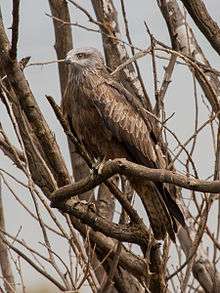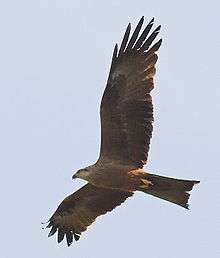Kite (bird)
| Kite | |
|---|---|
 | |
| Milvus migrans | |
| Scientific classification | |
| Kingdom: | Animalia |
| Phylum: | Chordata |
| Class: | Aves |
| Order: | Accipitriformes |
| Family: | Accipitridae |
Kite is a common name for certain birds of prey in the family Accipitridae, particularly in subfamilies Milvinae, Elaninae, and Perninae.[1]
Some authors use the terms "hovering kite" and "soaring kite" to distinguish between Elanus and the milvine kites, respectively. The groups may also be differentiated by size, referring to milvine kites as "large kites", and elanine kites as "small kites".
Species
- Subfamily Elaninae
- Genus Elanus
- Black-winged kite, Elanus caeruleus
- Black-shouldered kite, Elanus axillaris
- White-tailed kite, Elanus leucurus
- Letter-winged kite, Elanus scriptus
- Genus Chelictinia
- Scissor-tailed kite, Chelictinia riocourii
- Genus Gampsonyx
- Pearl kite, Gampsonyx swainsonii
- Genus Elanus
- Subfamily Harpiinae
- Genus Machaerhamphus
- Bat hawk, Machaerhamphus alcinus – traditionally Elaninae or Falconinae
- Genus Machaerhamphus
- Subfamily Elaninae or Perninae
- Genus Elanoides – often classified in Perninae
- Swallow-tailed kite, Elanoides forficatus
- Genus Elanoides – often classified in Perninae
- Subfamily Milvinae
- Genus Haliastur
- Whistling kite, Haliastur sphenurus
- Brahminy kite, Haliastur indus
- Genus Milvus
- Red kite, Milvus milvus
- Cape Verde kite, Milvus (milvus) fasciicauda – extinct (2000)
- Black kite, Milvus migrans
- Black-eared kite, Milvus (migrans) lineatus
- Yellow-billed kite, Milvus (migrans) aegyptius
- Red kite, Milvus milvus
- Genus Haliastur
- Subfamily Milvinae or Buteoninae, or tribe Harpagini
- Genus Harpagus
- Double-toothed kite, Harpagus bidentatus
- Rufous-thighed kite, Harpagus diodon
- Genus Harpagus
- Subfamily Milvinae or Buteoninae
- Genus Ictinia
- Mississippi kite, Ictinia mississippiensis
- Plumbeous kite, Ictinia plumbea
- Genus Rostrhamus
- Snail kite, Rostrhamus sociabilis
- Genus Helicolestes
- Slender-billed kite, Helicolestes hamatus – formerly in Rostrhamus
- Genus Ictinia
- Subfamily Milvinae or Perninae
- Genus Lophoictinia
- Square-tailed kite, Lophoictinia isura
- Genus Hamirostra
- Black-breasted buzzard, Hamirostra melanosternon
- Genus Lophoictinia
A few of the traditional Perninae are also called kites.
- Grey-headed kite, Leptodon cayanensis
- White-collared kite, Leptodon forbesi
- Hook-billed kite, Chondrohierax uncinatus
Taxonomy and systematics
19th century
In 1824, Vigors[2] proposed five divisions or stirpes of the Falconidae family: Aquilina (eagles), Accipitrina (hawks), Falconina (falcons), Buteonina (buzzards) and Milvina (kites, containing two genera Elanus and Milvus). He characterized the kites as having weaker bill and feebler talons than the buzzards, tail more or less forked, and wings longer than the tail.[2](p314)
In Elanus, he grouped the black-winged kite (now several Elanus spp.), scissor-tailed kite (now Chelictinia), and swallow-tailed kite (now Elanoides). These species all have pointed wings with the second primary the longest. The pattern of scales on the legs (acrotarsi) is reticulated, and the toes are separated. But Vigors noted that only the black-winged kite had rounded undersides on the nails of its talons, a trait found in the osprey but not in any other raptors, and thus suggested a separation of Elanus into two sections.[2](p333) A year later, he established a separate genus Nauclerus for the scissor- and swallow-tailed kites.[3]
Milvus contained the familiar red and black kites. The fourth primary feather is the longest, leg scales are scutellated, and the exterior toe is united to the middle toe by a membrane.[2](p334)
Vigors placed Ictinia – "the Milan Cresserelle of M. Vieillot" and "the Mississippi Kite of Mr. Wilson" – into Buteonina. Though noting that "the wings are of considerable length, extending far beyond the tail, a character which has induced M. Vieillot and others to place this bird near the Kites", he wrote that the strong affinity in characteristics and manners warranted it to be placed closer to the falcons.[2](p331)
20th century
Swann's 1922 synopsis grouped all the kites together with the "cuckoo-falcons" and honey buzzards into a large Milvinæ subfamily.[4] His order was: Elanoides, Chelictinia, Milvus, Lophoictinia, Rostrhamus, Helicolestes, Chondrohierax, Odontriorchis, Gypoictinia (=Hamirostra), Elanus, Gampsonyx, Ictinia, Harpagus, Baza, Aviceda, Henicopernis, Machærhamphus, Pernis.
In contrast, Peters[5] grouped the large kites into subfamily Milvinae and most small kites into Elaninae, with a few small kites joining the honey-buzzards and bazas in Perninae. His arrangement of kite genera was as follows:
- Elaninae: Elanus, Chelictinia, Machaerhamphus.
- Perninae: Elanoïdes, (Aviceda, Henicopernis, Pernis, Odontotriorchis), Chondrohierax.
- Milvinae: Harpagus, Ictinia, Rostrhamus, Helicolestes, Milvus, Lophoictinia, Hamirostra, Haliastur.
- Polyhieracinae: Gampsonyx
The pearl kite Gampsonyx had variously been placed with the accipiters, forest-falcons, or elanine kites. It was not until the 1960s that a similar molt schedule established its affinity to Elanus.
21st century
By 2015, genetic research showed that many of the kite genera are related to the honey-buzzards, and that the tiny bat hawk (Machaerhamphus or Macheirhamphus) is actually related to the huge harpy eagles. Several of the large kites are related more closely to the Buteo hawks (buzzards) than to the group of "true" kites and sea-eagles.
Boyd[6] places the "true" milvine kites (Milvus and Haliastur) with the sea-eagles in tribe Milvini within Buteoninae. This results in the following arrangement (genera in parentheses are not generally called kites):
- Elaninae: Gampsonyx, Chelictinia, Elanus.
- Perninae: Chondrohierax, Leptodon, Elanoides, (Pernis), Hamirostra, Lophoictinia, (Henicopernis).
- Buteoninae
- Harpagini: Harpagus.
- Milvini: Haliastur, Milvus, (Haliaeetus, Icthyophaga).
- Buteonini: many genera, including the kites Ictinia, Rostrhamus, and Helicolestes.
- Ictinia is near-basal, after the Old-World genus Butastur. Rostrhamus and Helicolestes form a clade with the black-collared hawk (Busarellus) and the crane hawk (Geranospiza).
Interestingly, as early as 1882, Anton Reichenow had also placed Section Milvinæ alongside Section Buteoninæ in Subfamily Buteoninæ.[7](p18)
In mythology
Isis is said in ancient Egyptian mythology to have taken the form of a kite in various situations in order to resurrect the dead.[8]
References
- ↑ "kite". Encyclopædia Britannica. Encyclopædia Britannica Online. Encyclopædia Britannica Inc., 2014. Web. 24 Nov. 2014 <http://www.britannica.com/EBchecked/topic/319664/kite>.
- 1 2 3 4 5 Vigors, Nicholas Aylward (June 1824). "On the groups of the Falconidæ". Sketches in Ornithology. The Zoological Journal. 1 (2): 308–346. Retrieved 2016-03-13.
- ↑ Vigors, Nicholas Aylward (October 1825). "On a new genus of Falconidæ". Sketches in Ornithology. The Zoological Journal. 2 (7): 385–386.
- ↑ Swann, H. Kirke (1922). "Sub-Fam. VI Milvinæ". A synopsis of the Accipitres (diurnal birds of prey) comprising species and subspecies described up to 1920, with their characters and distribution. (2 ed.). London. pp. 150–178.
- ↑ Peters, 1931. Check-list of Birds of the World, volume 1, pages 192 to 205.
- ↑ Taxonomy in Flux checklist: Accipitriformes "One thing that genetic results have made clear is that the kites are not a natural group. ... Kites also occur in three clades in Perninae and four clades in Buteoninae." "Three groups of kites are part of Perninae. The Neotropical Chondrohierax and Leptodon kites, the Swallow-tailed Kite (Elanoides, sister to the Pernis honey-buzzards), and the Square-tailed Kite (Lophoictinia, sister to the Henicopernis honey-buzzards). Note that the honey-buzzards are not a natural group either."
- ↑ Sharpe, Richard Bowdler (1891). A review of recent attempts to classify birds; an address delivered before the Second international ornithological congress on the 18th of May, 1891, by R. Bowdler Sharpe. Budapest: Office of the Second International Ornithological Congress.
In 1882 appeared Dr. Reichenow's 'Die Vogel der Zoologischen Gärten', with a scheme of arrangement of birds"
- ↑ "Isis the Goddess." Egyptian Gods. Siteseen Ltd., June 2014. Web. 24 Nov. 2014. <http://www.landofpyramids.org/isis.htm>.
External links
- Weekly Radio Segments from With the Wild Things: Kites
- Kite videos on the Internet Bird Collection
